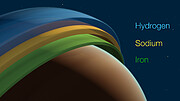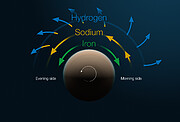Komunikat prasowy
„To jest science-fiction”: pierwsze obserwacje 3D atmosfery jednej z egzoplanet ukazują unikalny klimat
18 lutego 2025
Astronomowie zajrzeli przez atmosferę planety poza Układem Słonecznym, po raz pierwszy mapując jej strukturę w 3D. Dzięki połączeniu wszystkich czterech teleskopów głównych stanowiących Bardzo Duży Teleskop (VLT), należący do Europejskiego Obserwatorium Południowego (ESO), znaleziono potężne wiatry niosące pierwiastki chemiczne takie jak żelazo i tytan, tworzące skomplikowane wzorce pogodowe w atmosferze planety. Odkrycie otwiera drzwi do szczegółowych badań składu chemicznego i pogody obcych światów.
„Atmosfera tej planet zachowuje się w sposób, który stanowi wyzwanie dla naszego zrozumienia funkcjonowania pogody – nie tylko na Ziemi, ale także na innych planetach. Wydaje się to kompletnym science-fiction” mówi Julia Victoria Seidel, badaczka z Europejskiego Obserwatorium Południowego (ESO) w Chile, główna autorka badań opublikowanych dzisiaj w Nature.
Planeta WASP-121b (znana także jako Tylos), znajduje się około 900 lat świetlnych od nas w kierunku konstelacji Rufy. Jest to ultragorący jowisz, gazowy olbrzym krążący wokół swojej gwiazdy tak blisko, że jeden rok trwa tam zaledwie około 30 ziemskich godzin. Co więcej, jedna strona planety jest gorąca, ponieważ jest zawsze zwrócona do gwiazdy, podczas gdy druga strona jest znacznie chłodniejsza.
Zespół zbadał głębiny atmosfery Tylos i ujawnił wiatry wieją w osobnych warstwach. Utworzono trójwymiarową mapę struktury atmosfery. Po raz pierwszy astronomowie byli w stanie zbadać atmosferę planety spoza Układu Słonecznego na takiej głębokości i takich szczegółach.
„To co znaleźliśmy było zaskakujące: strumień obraca materię wokół równika planety, podczas gdy oddzielny przepływ na niższych poziomach atmosfery przemieszcza gaz od gorącej strony do chłodniejszej. Ten rodzaj klimatu nie był dotąd nigdy widziany na żadnej planety” wskazuje Seidel, która jest także badaczką w Lagrange Laboratory, stanowiącym część Observatoire de la Côte d'Azur we Francji. Obserwowany strumień rozciąga się na połowę planety, nabierając prędkości i gwałtownie wzburzając atmosferę wysoko na niebie, gdy przecina gorącą stronę Tylos. „Nawet najsilniejsze huragany w Układzie Słonecznym wydają się spokojne w porównaniu do tego” dodaje badaczka.
Aby odkryć trójwymiarową strukturę atmosfery egzoplanet, zespół użył instrumentu ESPRESSO na VLT, aby połączyć światło z jego czterech wielkich teleskopów głównych w jeden sygnał. Ten połączony tryb pracy VLT zbiera cztery razy więcej światła niż pojedynczy teleskop główny, ujawniając słabsze szczegóły. Obserwując planetę podczas jednego pełnego tranzytu na tle gwiazdy macierzystej, ESPRESSO był w stanie wykryć sygnatury wielu pierwiastków chemicznych, próbkując w efekcie różne warstwy atmosfery.
„VLT pozwolił nam zbadać trzy równe warstwy atmosfery egzoplanet za jednym zamachem” mówi współautor badań Leonardo A. dos Santos ze Space Telescope Science Institute w Baltimore (Stany Zjednoczone). Zespół śledził ruchy żelaza, sodu i wodoru, co pozwoliło na prześledzenie wiatrów odpowiednio w głębokiej, średniej i płytkiej warstwie planetarnej atmosfery. „Taki rodzaj obserwacji jest bardzo trudny do wykonania przez teleskopy kosmiczne, co podkreśla znaczenie naziemnych obserwacji egzoplanet” dodaje naukowiec.
Co ciekawe, obserwacje ujawniają także występowanie tytanu tuż pod strumieniem, co wskazano w towarzyszącym badaniu opublikowanym w Astronomy and Astrophysics. Była to kolejna niespodzianka, ponieważ wcześniejsze obserwacje planety pokazały brak tego pierwiastka, prawdopodobnie dlatego, iż jest ukryty głęboko w atmosferze.
To naprawdę niesamowite, że jesteśmy w stanie badać szczegóły takie, jak skład chemiczny i wzorce pogodowe planety na tak olbrzymich odległościach” komentuje Bibiana Prinoth, doktorantka na Lund University (Szwecja) i w ESO, która kierowała badaniami towarzyszącymi i jest współautorką publikacji w Nature.
Aby odkryć atmosfery mniejszych, podobnych do Ziemi planet, potrzebne będą jednak większe teleskopy. Wśród nich będzie Ekstremalnie Wielki Teleskop (ELT), który jest obecnie budowany przez ESO na chilijskiej pustyni Atakama, a także jego instrument ANDES.
„ELT będzie przełomem w badaniach atmosfer egzoplanet” mówi Prinoth. „Niniejsze doświadczenie sprawia, że czuję iż jesteśmy na skraju odkrycia niesamowitych rzeczy, o których aktualnie możemy tylko pomarzyć.”
Więcej informacji
Wyniki badań zaprezentowano w artykule pt. „Vertical structure of an exoplanet’s atmospheric jet stream” (doi:10.1038/s41586-025-08664-1), opublikowanym w czasopiśmie Nature.
Skład zespołu badawczego: Julia V. Seidel (Europejskie Obserwatorium Południowe, Santiago, Chile [ESO Chile]; Laboratoire Lagrange, Observatoire de la Côte d’Azur, CNRS, Université Côte d’Azur, Nicea, Francja [Lagrange]), Bibiana Prinoth (ESO Chile oraz Lund Observatory, Division of Astrophysics, Department of Physics, Lund University, Lund, Szwecja [ULund]), Lorenzo Pino (INAF-Osservatorio Astrofisico di Arcetri, Florencja, Włochy), Leonardo A. dos Santos (Space Telescope Science Institute, Baltimore, USA, Johns Hopkins University, Baltimore, USA), Hritam Chakraborty (Observatoire de Genève, Département d’Astronomie, Université de Genève, Versoix, Szwajcaria [UNIGE]), Vivien Parmentier (Lagrange), Elyar Sedaghati (ESO Chile), Joost P. Wardenier (Département de Physique, Trottier Institute for Research on Exoplanets [IREx], Université de Montréal, Kanada), Casper Farret Jentink (UNIGE), Maria Rosa Zapatero Osorio (Centro de Astrobiología, CSIC-INTA, Madryt, Hiszpania), Romain Allart (IREx), David Ehrenreich (UNIGE), Monika Lendl (UNIGE), Giulia Roccetti (Europejskie Obserwatorium Południowe, Garching bei München, Niemcy; Meteorologisches Institut, Ludwig-Maximilians-Universität München, Monachium, Niemcy), Yuri Damasceno (Instituto de Astrofísica e Ciências do Espaço, Universidade do Porto, Porto, Portugalia [IA-CAUP], Departamento de Fisica e Astronomia, Faculdade de Ciências, Universidade do Porto, Porto, Portugalia [FCUP]; ESO Chile), Vincent Bourrier (UNIGE), Jorge Lillo-Box (Centro de Astrobiología (CAB); CSIC-INTA, Madryt, Hiszpania), H. Jens Hoeijmakers (ULund), Enric Pallé (Instituto de Astrofísica de Canarias, La Laguna, Tenerife, Hiszpania [IAC]; Departamento de Astrofísica, Universidad de La Laguna, La Laguna, Tenerife, Hiszpania [IAC-ULL]), Nuno Santos (IA-CAUP oraz FCUP), Alejandro Suàrez Mascareño (IAC oraz IAC-ULL), Sergio G. Sousa (IA-CAUP), Hugo M. Tabernero (Departamento de Física de la Tierra y Astrofísica & IPARCOS-UCM (Instituto de Física de Partículas y del Cosmos de la UCM), Universidad Complutense de Madrid, Hiszpania) oraz Francesco A. Pepe (UNIGE).
Towarzyszące badania, w których odkryto występowanie tytanu, opublikowano w czasopiśmie Astronomy & Astrophysics w artykule pt. „Titanium chemistry of WASP-121 b with ESPRESSO in 4-UT mode” (doi: 10.1051/0004-6361/202452405)
Skład zespołu badawczego: Bibiana Prinoth (Europejskie Obserwatorium Południowe, Santiago, Chile [ESO Chile] oraz Lund Observatory, Division of Astrophysics, Department of Physics, Lund University, Lund, Szwecja [ULund]), Julia V. Seidel (ESO Chile; Laboratoire Lagrange, Observatoire de la Côte d’Azur, CNRS, Université Côte d’Azur, Nicea, Francja [Lagrange]), H. Jens Hoeijmakers (ULund), Brett M. Morris (Space Telescope Science Institute, Baltimore, USA), Martina Baratella (ESO Chile), Nicholas W. Borsato (ULund, School of Mathematical and physical Sciences, Macquarie University, Sydney, Australia), Yuri Damasceno (Instituto de Astrofísica e Ciências do Espaço, Universidade do Porto, Porto, Portugalia [IA-CAUP], Departamento de Fisica e Astronomia, Faculdade de Ciências, Universidade do Porto, Porto, Portugalia [FCUP]; ESO Chile), Vivien Parmentier (Lagrange), Daniel Kitzmann (University of Bern, Physics Institute, Division of Space Research & Planetary Sciences, Berno, Szwajcaria), Elyar Sedaghati (ESO Chile), Lorenzo Pino (INAF-Osservatorio Astrofisico di Arcetri, Florencja, Włochy), Francesco Borsa (INAF-Osservatorio Astronomico di Brera, Merate, Włochy), Romain Allart (Département de Physique, Trottier Institute for Research on Exoplanets [IREx], Université de Montréal, Kanada), Nuno Santos (IA-CAUP oraz FCUP), Michal Steiner (Observatoire de l'Université de Genève, Versoix, Switzerland), Alejandro Suàrez Mascareño (Instituto de Astrofísica de Canarias, La Laguna, Tenerife, Hiszpania; Departamento de Astrofísica, Universidad de La Laguna, La Laguna, Tenerife, Hiszpania), Hugo M. Tabernero (Departamento de Física de la Tierra y Astrofísica & IPARCOS-UCM (Instituto de Física de Partículas y del Cosmos de la UCM), Universidad Complutense de Madrid, Hiszpania) oraz Maria Rosa Zapatero Osorio (Centro de Astrobiologia, CSIC-INTA, Madrid, Hiszpania).
Europejskie Obserwatorium Południowe (ESO) umożliwia naukowcom z całego świata na odkrywanie tajemnic Wszechświata z korzyścią dla nas wszystkich. Projektujemy, budujemy i zarządzamy światowej klasy obserwatoriami naziemnymi – których astronomowie używają do odpowiadania na ciekawe pytania i szerzenia fascynacji astronomią – a także promujemy międzynarodową współpracę w astronomii. Ustanowione w 1962 roku jako organizacja międzynarodowa, ESO jest wspierane przez 16 krajów członkowskich (Austria, Belgia, Czechy, Dania, Finlandia, Francja, Hiszpania, Irlandia, Holandia, Niemcy, Polska, Portugalia, Szwajcaria, Szwecja, Wielka Brytania oraz Włochy), a także Chile jako kraj gospodarz, oraz Australię jako strategicznego partnera. Siedziba ESO, a także jego centrum popularyzacji nauki i planetarium (ESO Supernova) znajdują się w pobliżu Monachium w Niemczech, natomiast chilijska pustynia Atakama – niesamowite miejsce z wyjątkowymi warunkami do obserwacji nieba – jest domem dla naszych teleskopów. ESO zarządza trzema lokalizacjami obserwacyjnymi w Chile: La Silla, Paranal i Chajnantor. W Paranal ESO posiada teleskop VLT (Very Large Telescope – Bardzo Duży Teleskop) oraz dwa teleskopy do przeglądów nieba. VISTA pracuje w podczerwieni, VLT Survey Telescope w zakresie widzialnym. W Paranal ESO zarządza także południowym obserwatorium CTA (Cherenkov Telescope Array South) – największym na świecie i najbardziej czułym obserwatorium promieniowania gamma. Wspólnie z międzynarodowymi partnerami ESO zarządza także radioteleskopami APEX i ALMA, które są instrumentami do obserwacji nieba w zakresach milimetrowym i submilimetrowym. Na Cerro Armazones, niedaleko Paranal, budujemy „największe oko świata na niebo”, czyli Ekstremalnie Wielki Teleskop (Extremely Large Telescope, ELT). Nasza działalność w Chile jest zarządzana z biur ESO w Santiago, gdzie współpracujemy też z chilijskimi partnerami.
Linki
- Publikacja naukowa (Nature)
- Publikacja naukowa (A&A)
- Zdjęcia VLT
- Dowiedz się więcej o Ekstremalnie Wielkim Teleskopie budowanych przez ESO - informacje na naszej dedykowanej witrynie oraz w paczce prasowej
- Dla dziennikarzy: zasubskrybuj, aby otrzymywać komunikaty w swoim języku z embargo medialnym oraz azaaplikuj o udział w strategicznej wizycie medialne jw ESO (częściowo finansowanej) (NOWOŚĆ)
- Dla naukowców: jeśli masz ciekawy temat, zgłoś swoje badania
- World's Najciemniejsze i najczystsze niebo zagrożone przez przemysłowy megaprojekt
Kontakt
Julia Victoria Seidel
European Southern Observatory (ESO) and Lagrange Laboratory, Observatoire de la Côte d'Azur
Santiago, Chile and Nice, France
Tel.: +33 743 32 79 73
E-mail: jseidel@oca.eu
Bibiana Prinoth
Lund University
Lund, Sweden
Tel.: +46 72 442 03 69
E-mail: bibiana.prinoth@fysik.lu.se
Leonardo A. dos Santos
Space Telescope Science Institute
Baltimore, USA
Tel.: +1 (410) 338-4395
E-mail: ldsantos@stsci.edu
Bárbara Ferreira
ESO Media Manager
Garching bei München, Germany
Tel.: +49 89 3200 6670
Tel. kom.: +49 151 241 664 00
E-mail: press@eso.org
Krzysztof Czart (Kontakt dla mediów Polska)
Sieć Popularyzacji Nauki ESO
oraz Urania - Postępy Astronomii
Toruń, Polska
Tel.: +48 513 733 282
E-mail: eson-poland@eso.org
O komunikacie
| Komunikat nr: | eso2504pl |
| Nazwa: | WASP-121b |
| Typ: | Milky Way : Star : Circumstellar Material : Planetary System |
| Facility: | Very Large Telescope |
| Instrumenty: | ESPRESSO |
| Science data: | 2025Natur.639..902S |
Our use of Cookies
We use cookies that are essential for accessing our websites and using our services. We also use cookies to analyse, measure and improve our websites’ performance, to enable content sharing via social media and to display media content hosted on third-party platforms.
ESO Cookies Policy
The European Organisation for Astronomical Research in the Southern Hemisphere (ESO) is the pre-eminent intergovernmental science and technology organisation in astronomy. It carries out an ambitious programme focused on the design, construction and operation of powerful ground-based observing facilities for astronomy.
This Cookies Policy is intended to provide clarity by outlining the cookies used on the ESO public websites, their functions, the options you have for controlling them, and the ways you can contact us for additional details.
What are cookies?
Cookies are small pieces of data stored on your device by websites you visit. They serve various purposes, such as remembering login credentials and preferences and enhance your browsing experience.
Categories of cookies we use
Essential cookies (always active): These cookies are strictly necessary for the proper functioning of our website. Without these cookies, the website cannot operate correctly, and certain services, such as logging in or accessing secure areas, may not be available; because they are essential for the website’s operation, they cannot be disabled.
Functional Cookies: These cookies enhance your browsing experience by enabling additional features and personalization, such as remembering your preferences and settings. While not strictly necessary for the website to function, they improve usability and convenience; these cookies are only placed if you provide your consent.
Analytics cookies: These cookies collect information about how visitors interact with our website, such as which pages are visited most often and how users navigate the site. This data helps us improve website performance, optimize content, and enhance the user experience; these cookies are only placed if you provide your consent. We use the following analytics cookies.
Matomo Cookies:
This website uses Matomo (formerly Piwik), an open source software which enables the statistical analysis of website visits. Matomo uses cookies (text files) which are saved on your computer and which allow us to analyze how you use our website. The website user information generated by the cookies will only be saved on the servers of our IT Department. We use this information to analyze www.eso.org visits and to prepare reports on website activities. These data will not be disclosed to third parties.
On behalf of ESO, Matomo will use this information for the purpose of evaluating your use of the website, compiling reports on website activity and providing other services relating to website activity and internet usage.
Matomo cookies settings:
Additional Third-party cookies on ESO websites: some of our pages display content from external providers, e.g. YouTube.
Such third-party services are outside of ESO control and may, at any time, change their terms of service, use of cookies, etc.
YouTube: Some videos on the ESO website are embedded from ESO’s official YouTube channel. We have enabled YouTube’s privacy-enhanced mode, meaning that no cookies are set unless the user actively clicks on the video to play it. Additionally, in this mode, YouTube does not store any personally identifiable cookie data for embedded video playbacks. For more details, please refer to YouTube’s embedding videos information page.
Cookies can also be classified based on the following elements.
Regarding the domain, there are:
- First-party cookies, set by the website you are currently visiting. They are stored by the same domain that you are browsing and are used to enhance your experience on that site;
- Third-party cookies, set by a domain other than the one you are currently visiting.
As for their duration, cookies can be:
- Browser-session cookies, which are deleted when the user closes the browser;
- Stored cookies, which stay on the user's device for a predetermined period of time.
How to manage cookies
Cookie settings: You can modify your cookie choices for the ESO webpages at any time by clicking on the link Cookie settings at the bottom of any page.
In your browser: If you wish to delete cookies or instruct your browser to delete or block cookies by default, please visit the help pages of your browser:
Please be aware that if you delete or decline cookies, certain functionalities of our website may be not be available and your browsing experience may be affected.
You can set most browsers to prevent any cookies being placed on your device, but you may then have to manually adjust some preferences every time you visit a site/page. And some services and functionalities may not work properly at all (e.g. profile logging-in, shop check out).
Updates to the ESO Cookies Policy
The ESO Cookies Policy may be subject to future updates, which will be made available on this page.
Additional information
For any queries related to cookies, please contact: pdprATesoDOTorg.
As ESO public webpages are managed by our Department of Communication, your questions will be dealt with the support of the said Department.





